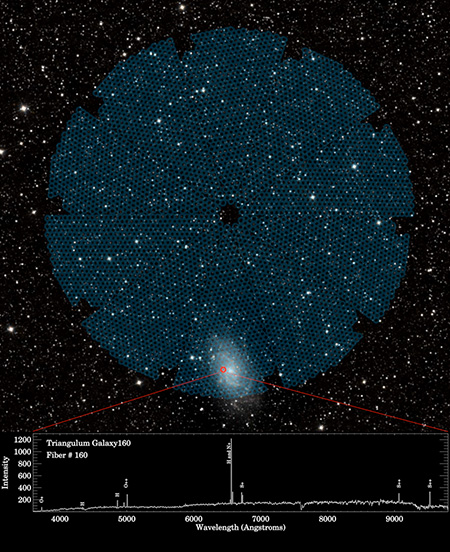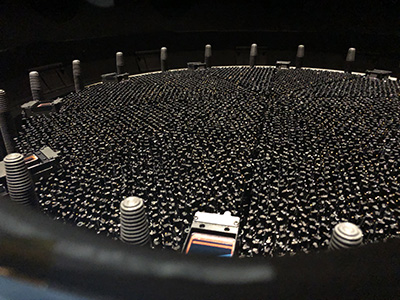A new instrument mounted atop a telescope in Arizona has aimed its robotic array of 5,000 fiber-optic “eyes” at the night sky to capture the first images showing its unique view of galaxy light.
It was the first test of the Dark Energy Spectroscopic Instrument, known as DESI, with its nearly complete complement of components. The long-awaited instrument is designed to explore the mystery of dark energy, which makes up about 68 percent of the universe and is speeding up its expansion.
Connie Rockosi, professor and co-chair of astronomy and astrophysics at UC Santa Cruz, serves on the DESI Leadership Team. As the commissioning scientist, she has the job of planning and coordinating the work of a team of scientists and engineers from throughout the DESI collaboration to demonstrate that the instrument is ready to start scientific observations.
“It’s a real thrill to be part of making everything come together as a working instrument that will do exciting science. This is a milestone achievement of many years of work by many people in DESI,” Rockosi said.
DESI’s components are designed to automatically point at preselected sets of galaxies, gather their light, and then split that light into narrow bands of color to precisely map their distance from Earth and gauge how much the universe expanded as this light traveled to Earth. In ideal conditions, DESI can cycle through a new set of 5,000 galaxies every 20 minutes.
The latest milestone marks the opening of DESI’s final testing toward the formal start of observations in early 2020.
Time machine
Like a powerful time machine, DESI will peer deeply into the universe’s infancy and early development—up to about 11 billion years ago—to create the most detailed 3-D map of the universe.
By repeatedly mapping the distance to 35 million galaxies and 2.4 million quasars across one-third of the area of the sky over its five-year run, DESI will teach us more about dark energy. Quasars, among the brightest objects in the universe, allow DESI to look deeply into the universe’s past.
DESI will provide very precise measurements of the universe’s expansion rate. Gravity had slowed this rate of expansion in the early universe, though dark energy has since been responsible for speeding up its expansion.
“After a decade in planning and R&D, installation and assembly, we are delighted that DESI can soon begin its quest to unravel the mystery of dark energy,” said DESI Director Michael Levi of the Department of Energy’s Lawrence Berkeley National Laboratory (Berkeley Lab), the lead institution for DESI’s construction and operations.
"Most of the universe’s matter and energy are dark and unknown, and next-generation experiments like DESI are our best bet for unraveling these mysteries,” Levi added. “I am thrilled to see this new experiment come to life.”
The DESI collaboration has participation from nearly 500 researchers at 75 institutions in 13 countries. At UC Santa Cruz, Alexie Leauthaud and J. Xavier Prochaska, both professors of astronomy and astrophysics, are involved in the collaboration along with Rockosi. Leauthaud serves on the DESI Science Committee.
Installation
Installation of DESI began in February 2018 at the Nicholas U. Mayall Telescope at Kitt Peak National Observatory near Tucson, Arizona. “With DESI we are combining a modern instrument with a venerable old telescope to make a state-of-the-art survey machine.” said Lori Allen, director of Kitt Peak National Observatory at the National Science Foundation’s National Optical-Infrared Astronomy Research Laboratory.
Over the past 18 months, a bevy of DESI components were shipped to the site from institutions around the globe and installed on the telescope. Jiani Ding, an astronomy graduate student from UC Santa Cruz, has been on site to help with the installation.
Among the early arrivals was an assembly of lenses packaged in a large steel barrel, together weighing in at three tons. This corrector barrel sits over the 4-meter primary mirror of the Mayall Telescope and provides an expansive field of view. The lenses, each measuring about a meter across, were successfully tested in April.
DESI’s focal plane, which carries 5,000 robotic positioners that swivel in a choreographed “dance” to focus individually on galaxies, is at the top of the telescope.
These little robots—which each hold a light-gathering fiber-optic cable that is about the average width of a human hair—serve as DESI’s eyes. It takes about 10 seconds for the positioners to swivel to a new sequence of targeted galaxies. With its unprecedented surveying speed, DESI will map over 20 times more objects than any predecessor experiment.
The focal plane, which is comprised of a half-million individual parts, is arranged in a series of 10 wedge-shaped petals that each contain 500 positioners and a little camera to help the telescope point and focus.
The focal plane, corrector barrel, and other DESI components weigh 11 tons, and the Mayall telescope’s movable arm that DESI is installed on weighs 250 tons and rises 90 feet above the floor in the Mayall’s 14-story dome.
Among the more recent arrivals at Kitt Peak is the collection of spectrographs that are designed to split up the gathered light into three separate color bands to allow precise distance measurements of the observed galaxies across a broad range of colors.
These spectrographs, which allow DESI’s robotic eyes to “see” even faint, distant galaxies, are designed to measure redshift, which is a shift in the color of objects to longer, redder wavelengths due to the objects’ movement away from us. Redshift is analogous to how the sound of a fire engine’s siren shifts to lower tones as it moves away from us.
There are now eight spectrographs installed, with the final two arriving before year-end. To connect the focal plane with the spectrographs, which are located beneath the telescope, DESI is equipped with about 150 miles of fiber-optic cabling.
“This is a very exciting moment,” said Nathalie Palanque-Delabrouille, a DESI spokesperson and an astrophysics researcher at France’s Atomic Energy Commission (CEA) who has participated in the selection process to determine which galaxies and other objects DESI will observe.
“The instrument is all there. It has been very exciting to be a part of this from the start,” she said. “This is a very significant advance compared to previous experiments. By looking at objects very far away from us, we can actually map the history of the universe and see what the universe is composed of by looking at very different objects from different eras.”
Palanque-Delabrouille’s institution, CEA, contributed a specialized cooling system to optimize the performance of the light sensors (known as CCDs or charge-coupled devices) that enable DESI’s broad color-sampling range.
Gregory Tarlé, a physics professor at the University of Michigan (UM) who led the student teams that assembled the robotic positioners for DESI and related components, said it’s gratifying to reach a stage in the project where all of DESI’s complex components are functioning together.
UM delivered a total of 7,300 robotic positioners, including spares. During the production peak, the teams were churning out about 50 positioners a day.
“It was quite a process,” Tarlé said. “We were at the limits of precision for these production parts.”
The positioners were installed in the focal plane petals at Berkeley Lab, and after assembly and testing the completed petals were shipped to Kitt Peak and installed one at a time on the Mayall Telescope.
Now that the hard work of building DESI is largely done, Tarlé said he looks forward to DESI discoveries.
“I want to find out what the nature of dark energy is,” he said. “We finally have a shot at really trying to understand the nature of this stuff that dominates the universe.”
DESI is supported by the U.S. Department of Energy’s Office of Science; the U.S. National Science Foundation, Division of Astronomical Sciences, under contract to the NSF’s National Optical-Infrared Astronomy Research Laboratory; the Science and Technologies Facilities Council of the United Kingdom; the Gordon and Betty Moore Foundation; the Heising-Simons Foundation; the French Alternative Energies and Atomic Energy Commission (CEA); the National Council of Science and Technology of Mexico; the Ministry of Economy of Spain; and DESI member institutions. The DESI scientists are honored to be permitted to conduct astronomical research on Iolkam Du’ag (Kitt Peak), a mountain with particular significance to the Tohono O’odham Nation. View the full list of DESI collaborating institutions, and learn more about DESI, at desi.lbl.gov.




